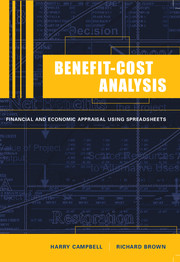Book contents
- Frontmatter
- Contents
- List of figures
- List of tables
- Preface
- Acknowledgements
- 1 Benefit-Cost Analysis: Introduction and Overview
- 2 Investment Appraisal: Principles
- 3 Investment Appraisal: Decision-Rules
- 4 Private Benefit-Cost Analysis: Financial Analysis
- 5 Efficiency Benefit-Cost Analysis
- 6 Calculating the Net Benefits to the Referent Group
- 7 Consumer and Producer Surplus in Benefit-Cost Analysis
- 8 Valuing Traded and Non-traded Commodities in Benefit-Cost Analysis
- 9 Incorporating Risk in Benefit-Cost Analysis
- 10 The Social Discount Rate, Cost of Public Funds, and the Value of Information
- 11 Weighting Net Benefits to Account for Income Distribution
- 12 Valuation of Non-marketed Goods
- 13 Economic Impact Analysis
- 14 Writing the Benefit-Cost Analysis Report
- Appendix 1 Case Study Assignment
- Appendix 2 Discount and Annuity Tables
- Index
7 - Consumer and Producer Surplus in Benefit-Cost Analysis
Published online by Cambridge University Press: 05 September 2012
- Frontmatter
- Contents
- List of figures
- List of tables
- Preface
- Acknowledgements
- 1 Benefit-Cost Analysis: Introduction and Overview
- 2 Investment Appraisal: Principles
- 3 Investment Appraisal: Decision-Rules
- 4 Private Benefit-Cost Analysis: Financial Analysis
- 5 Efficiency Benefit-Cost Analysis
- 6 Calculating the Net Benefits to the Referent Group
- 7 Consumer and Producer Surplus in Benefit-Cost Analysis
- 8 Valuing Traded and Non-traded Commodities in Benefit-Cost Analysis
- 9 Incorporating Risk in Benefit-Cost Analysis
- 10 The Social Discount Rate, Cost of Public Funds, and the Value of Information
- 11 Weighting Net Benefits to Account for Income Distribution
- 12 Valuation of Non-marketed Goods
- 13 Economic Impact Analysis
- 14 Writing the Benefit-Cost Analysis Report
- Appendix 1 Case Study Assignment
- Appendix 2 Discount and Annuity Tables
- Index
Summary
Introduction
So far in this book it has been assumed that undertaking a proposed project would have no effect on the market prices of goods and services. However, since the market economy consists of a complex network of inter-related output and input markets, it is possible, in principle, that undertaking the project will have wide-ranging effects on market prices. If the project's output or input quantities are small relative to the amounts traded in the markets for these goods and services, the effects on market prices will be small enough to be ignored, on the grounds that including them would have no bearing on the outcome of the analysis. While this “small project assumption” is a reasonable one for many of the projects which the analyst will encounter, it is necessary to be able to identify circumstances in which price changes are relevant, and to know how to deal with them in the benefit-cost analysis.
A project increases the aggregate supply of the output produced by the project, and increases the aggregate demand for the inputs used in the project. Significant changes in market supply or demand can result in changes in market prices. A significant change in supply or demand is one that is large relative to the quantity that would be bought and sold in the market in the absence of the project being undertaken. It is evident that there is little chance of such a change occurring where the output or input in question is traded on international markets, as will be discussed in Chapter 8.
- Type
- Chapter
- Information
- Benefit-Cost AnalysisFinancial and Economic Appraisal using Spreadsheets, pp. 146 - 176Publisher: Cambridge University PressPrint publication year: 2003



